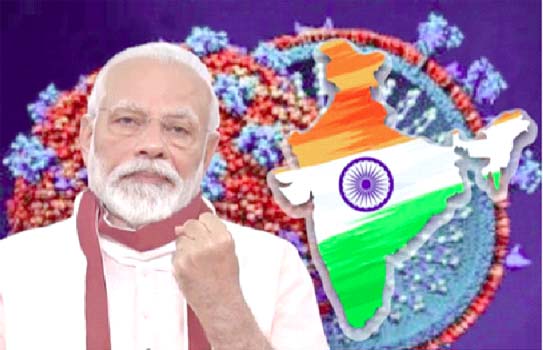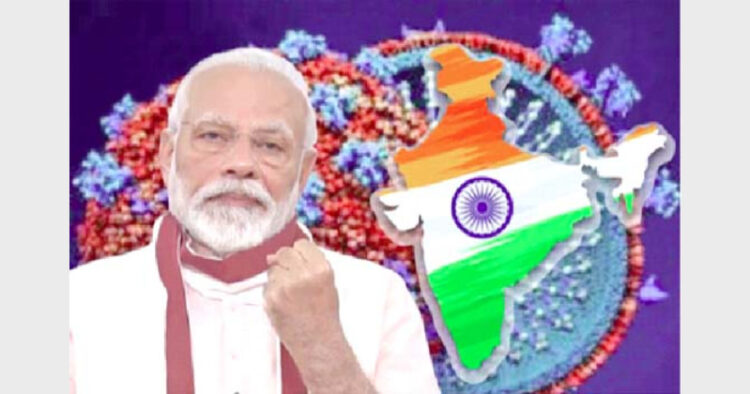Self-reliance or ‘Aatma Nirbharata’ will help India become one of the most developed and powerful countries. PM Modi has sounded the right bugle at the right time so that COVID19 turns into an opportunity for the nation

PM Modi announced a 20 Lakh crore package as part of the
‘Atmanirbhar Bharat’ abhiyan to boost the economy and rebuild lives
‘Atmanirbhar Bharat’ abhiyan to boost the economy and rebuild lives
On May 12, 2020, Prime Minister Shri Narendra Modi made a significant point about the nation becoming self-dependent during this COVID-19 pandemic crisis as he laid stress on ‘Atmanirbhar Bharat’. He said that a self-reliant India would stand on five pillars—Economy, which brings in quantum jump and not incremental change; Infrastructure, which should become the identity of India; System, based on 21st-century technology-driven arrangements; Vibrant Demography, which is our source of energy for a self-reliant India; and Demand, whereby the strength of our demand and supply chain should be utilised to full capacity. Since then, the entire nation has been talking on this aspect, and a few are also assessing the roadmap in that direction. Needless to say, this should always be the aspiration of a growing nation, and this current situation is an opportunity to reinforce that as espoused by the PM.

Effective use of EVMs, Aadhar and apps like MyGov,
Aarogya Setu have ensured people participation and democratisation of governance
Aarogya Setu have ensured people participation and democratisation of governance
Of particular interest is the reference to the 21st-century technology-driven arrangements for fostering a system based governance model that the PM has mentioned. The phases of the lockdown that we have so far encountered has not been a stoppage of many activities due to the enablement of so many functions due to technology—the most important being the constant availability of communication technology in its various dimensions. At the same time, many efforts have gone in to see how best many emerging problems are addressed with technology. The Aargoya Setu app is a case in point which was developed in a short time to help in contact tracing as part of the efforts of ensuring social distancing. Here was a private-public partnership that was used to build an app using two major technology and now helping a significant public health requirement.
India’s tryst with technology has been on since Independence, and they have helped in optimising agriculture and industry. However, such a leap was obtained with computing technology taking its place, and when this further connected with communications technology, their possibilities emerged on a much wider scale. The floodgates of opportunities and matching innovation came across many sectors, and now with artificial intelligence, machine learning and blockchain technology taking a very enhanced role, technology is almost ubiquitous in our daily lives.
The electronic voting machines (EVMs) and Unique Identity ‘Aadhar’ has changed the whole edifice of technology in governance. While the former has not only brought in significant transparency in the conduct of the elections and thereby the practice of democracy, Aadhar has ensured that our age-old gaps and leakages in public delivery systems got plugged. In a nutshell, both of these wide-ranging and most significant of its kind application of technology has enhanced India’s image as a nation that has successfully employed technology to such a broad base to improve governance and democracy. Even the efforts for technology empowerment to the broader masses like bank accounts of farmers being linked with digital methods based on the Unified Payment Interface (UPI) are helping digital payments to expand further and instil a sense of confidence among the users. India’s meteorology and weather forecasting technologies have also become world-class in a brief period, and today forecasting has become very accurate. NavIC, which is India’s navigational system, is another indigenous technology that functions with the Indian Regional Navigational Satellite System (IRNSS) and is now respected for his precision.
The floodgates of opportunities and innovation came across many sectors, and with AI, machine learning and block-chain, technology is almost ubiquitous in our daily lives
The importance of becoming self-reliant is being realised in the way forward where either the nation has to live with COVID-19 or in the post-pandemic situation. In this current situation, efforts like preparing face masks, development of COVID-19 testing kits and developing PPE (Personal Protection Equipment) have mushroomed across the country. Even ventilators have been designed and developed under partnerships by many corporations, large and small. Again tools developed in the country towards work from home and online classes for students and vocations have also found many successes. Not to forget the countless apps that facilitate many functions that allow e-commerce for essentials as well as provide tips for physical and mental wellness. The lakhs of start-ups have also not stopped their challenges and spurring the next round of innovations.
However, what is more, pertinent is where do we go as a nation in self-reliance in and with technology across sectors. With a global concern around China and news emanating of manufacturing shifting away from that country, will India be competitive enough to pick up some of the emerging opportunities based on our strengths? The Make in India and Make for the World clarion calls by the PM for some time can be best harnessed in these circumstances. Clearly, India’s advantage lies in its technical workforce base, but the challenge also lies in manufacturing technologies and available industrial parks with requisite technology and some states are already bolstering their capabilities to fill that gap. Even if one considers the healthcare market which is valued to be of around $370 Billion by 2022 and now in the highest priority of so many nations, India can be a major player with its technological push.
The technology ecosystem itself will see many business opportunities from an application perspective, and remote applicability of solutions will be more fostered globally. The future march of the nation with the introduction of the 5th Generation (5G) telecommunication technology to the development of indigenous AI and related technologies will be a major area of intervention whereby the Internet of Things (IoT) are widely deployed. NITI Aayog has rightly picked up on the potential of AI to transform the Indian economy and possible strategies that offer solutions for India’s future large scale inventions and healthcare facilities. More supply chain based deliveries, lesser human interventions and contacts will result in broader digitisation, and the whole Digital India mission mode project will be an opportunity and national priority enhanced. Likewise, cybersecurity will be a major area of intervention that the global community will look to India and can be realised with a special focus on national cybersecurity policy and India’s start-up brigade will be a major player.
Even in flagship areas like defence manufacturing where the nation spends significant foreign exchange in purchasing state of the art arms and equipment, domestic research & development and then manufacturing is already happening in many sectors. These are creating islands of capabilities, and the logical conclusion is to build systems and d system integration and hence produce indigenous equipments. AS more and more defence equipment and weapons today rely on IT and AI, India’s natural advantage is there. It is time to relook the roles that the Defence Research and Development Organisation (DRDO), the Ordnance Factory Board (OFB) and defence PSUs can play in the new frame of things. The private sector has also entered the sector and are taking baby steps and need to be fostered into an ecosystem of tier-based participation so that the military-industrial complex is built in the next decade. In the recent announcements by the finance minister equipment specifications optimisation and the corporatisation of OFB will serve well to bring in higher usage of defence technologies developed indigenously. Building on the projects under the India-US Defence Technology and Trade Initiative (DTTI) is a very prudent requirement because it will not only ensure manufacturing capacity around newer areas of technology but also generate a lot of future avenue for possibilities. India’s space technology programmes have always been on the forward curve, and this will be another area to focus on broader support for many activities.
Boost to self-reliance is already happening in flagship areas like defence manufacturing, domestic research & development and turnkey manufacturing where the nation spends significant foreign exchange
The fact remains that self-reliance comes in fostering a much expanded ecosystem where policies give the support and fillip, focused projects provide the motivation to complete projects within cost and time. Developments and application provide the substance and allow further growth. All these efforts create the right situation, which helps this confidence to grow towards more enhanced performance. India tryst with technology in many areas remain unabated, and individuals and institutions never lose the scientific temper and the quest to excel. Self-reliance will help India achieve to become one of the most developed and powerful countries in Asia. The time to act has come now. Let COVID-19 be the opportunity for the nation. The PM has sounded the right bugle at the right time, once again.
(The author is a columnist who writes on Cyberspace, defence & Asssam)













Comments